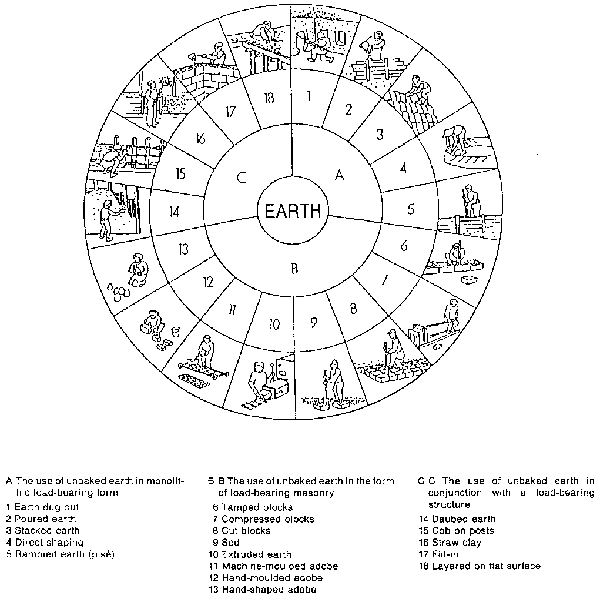
“A major building material
The importance – both in quantity and quality- of unbaked earth constructions in the world is very little known. Believed to be of ancient origin, (it is associated with the early civilisations of the Nile, Tigris and Euphrates, Indus and Huang He), nowadays, earth is not usually regarded as a major building material. This is despite the fact that it continues to leave an undeniable and distinctive imprint on the architectural landscapes, both rural and urban, of many countries. Unbaked earth is still, in fact, a major building material, being used extensively by people to erect homes and other buildings. Although sites of human occupation have seen constant regeneration with the passage of time, unbaked earth construction has persisted. Excavated from the soil itself, and moulded by the hand of man (or trampled by beasts of burden), the result is a building material which is used in all forms of construction-from simple huts and modest homes, to farm buildings, large houses, urban blocks, religious edifices, castles and palaces. The skills employed are based on knowledge acquired and refined over a long period of time.
A contemporary building material
While the use of earth in so called ‘advanced’ countries has declined in the 40 years since the end of the Second World War, in the developing countries it has continued unabated. In the former, the industrialisation of construction and other sweeping changes have rendered obsolete ancient techniques based on the use of local skills and materials, and on mutual help within communities. In the latter, various factors have dictated the continuing use of locally available solutions, materials and knowledge. These include shortages of processed materials (which are costly in both foreign currency and imported energy terms), the widening of the development ‘gap’, the accumulation of debt contracted within the international monetary system and the survival of local life-styles in which people are accustomed to coming to get her for mutual help for survival. In these countries, which have no industrial means, and which are to be found in various latitudes across the world, earth remains the main-if not the only- building material. Do these circumstances mean that it is a poor material, fashioned using outmoded techniques and unsuitable for promoting the development which is so necessary? The answer to this question is a clear ‘no’. On the contrary, the materials and techniques involved are generally of a high standard. They can ensure true architectural quality, allowing communities to continue creating their private or public living environments, and to integrate their buildings into a coherent framework of self-generated development which makes the most of the resources available, both human and material. In fact, scientific and architectural research into earth as a building material, and on related building techniques, has made considerable progress in recent decades. Combined with investments made by industrialists and construction companies, the result is that we now have a wide range of properly mastered production procedures and technical solutions available. These offer great flexibility in meeting a wide range of possible applications.”

Is there a larger or clearer image? It’s too pixelated and choppy to make out either text or pictures.
Sorry, you’ll have to see the original at their website. Our new blog software makes it too difficult to load large images.
See Gernot Minke’s Building with Earth book for lots of other earth building methods.
https://naturalbuildingblog.siterubix.com/gernot-minke-building-with-earth/